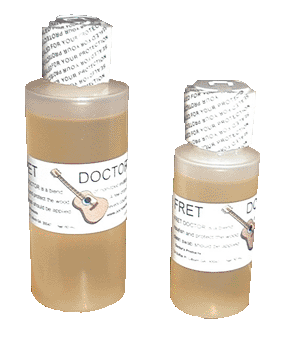
Bore Doctor![]()
![]() and Fret Doctor
and Fret Doctor![]()

A friend of mine in the Atlanta area, L.Omar Henderson, PhD., is a research chemist who also plays a clarinet made from Grenadilla wood. He has extensively researched the topic of bore oils, consulting with conservators in many European and American museums as well as principal musicians in major orchestras. This is what he has to say on the topic of bore oils:
Extensive research has shown that processed oils and waxes (most bore oils) actually clog the pores and fine structure of the wood fibers and hinder the transfer of moisture to the wood structure, while certain natural oils and antioxidants nourish and preserve the wood and the fine tonal qualities of wood instruments over the years. A proper water balance is necessary for the resonant qualities of wood instruments but too much or too little (and even the rapid flux ) can cause changes in resonance and the tendency to warp, split or crack the wood. Bore Doctor™ will not dull the tonal qualities of your instrument! Inexpensive insurance for your wood prone to cracking or splitting.
I
have researched the particular qualities and chemical structures of more than
100 plant oils, many types of plant antioxidant molecules (vitamin E is only a
fair antioxidant and works best in animal - not plant systems), and many natural
plant oil emulsifiers (different oils will separate over time and especially when
absorbed into a cellulose matrix (e.g. wood). I have formulated a mixture of more
common plant oils and some pretty exotic oils, natural plant antioxidant molecules,
and natural plant emulsifiers in a proprietary formulation. At ambient room temperatures
and even in my collection of quality control samples, there is no change in stability,
color, no development of rancidity or foul odors and effectiveness, in samples
now 7 years old (when I first settled on a perfected formulation). 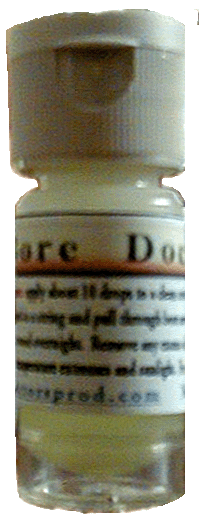

This especially formulated, all natural
blend of expensive non-toxic exotic oils, antioxidants, and stabilizers, controls
the dimensional stability and water balance of fine wood instruments. It really,
thoroughly soaks into the wood.
Water is both the enemy and the friend of fine wood musical instruments and controlling
the water sorption and description of (amount entering and leaving) the wood adds
dimensional stability, retards the tendency to crack or split, prevents water
logging, and improves the overall tone of the instrument. Your fine wood
instrument should last many years with
proper
care. Especially good for dry environments - necessary for damp climates. Most
bore oils on the market are cheap mineral oils!
Note from a very happy BoreDoctor user:
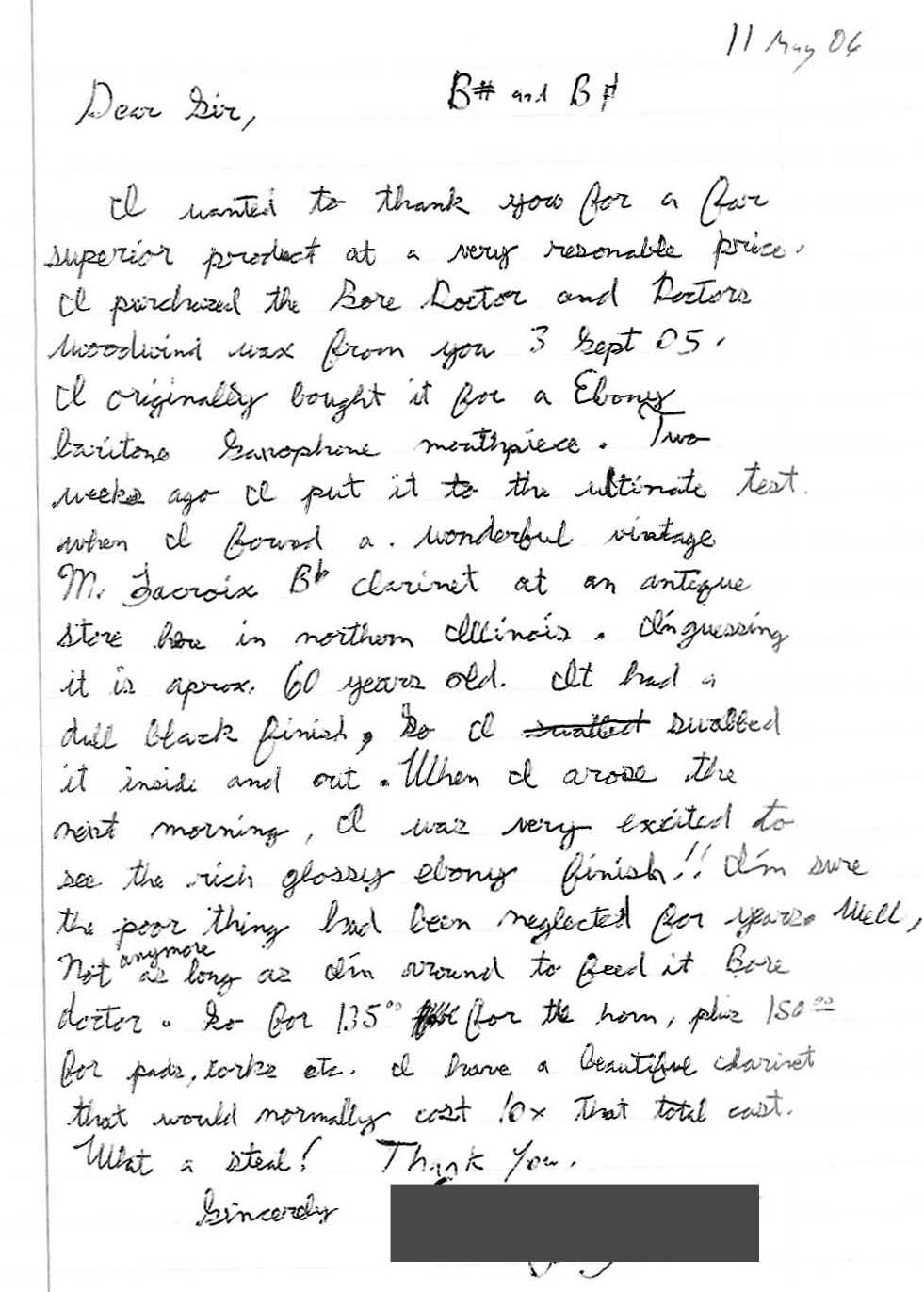
Fret
Doctor![]()
Guitar
players are sometimes troubled with the problem of micro cracking of their fretboards,
which can lead to other problems. Guitar fretboards and inlays are often made
from the very same hardwoods that are used in woodwinds like the fife: Rosewood,
Grenadilla or Blackwood, Boxwood, Cocobolo, and Ebony, just to name a few. Like
woodwinds, fretboards are sensitive to the problem of dimensional instability.
The fret beds expand as the wood shrinks, stressing the adhesive holding the frets
of the instrument, often developing the problem guitarists call "buzz."
The wood shrinks on the short axis, causing what is commonly referred to as "fret
sprout." The fret isn't growing...the wood is shrinking! The best way to
prevent these problems is to maintain the moisture level in the wood at where
it was when the instrument was constructed. Just like with woodwinds, mineral
oil, silicones, and various other substances don't really penetrate the wood.
The wood remains dry inside. 
In
late 2002, many members of the Les Paul Forum discovered what woodwind players
have known for years. Bore Doctor![]() actually penetrates hardwoods, returning the fingerboard to its natural
state and making it dimensionally stable. It can minimize the risk of future cracking
or splitting. Because of the larger surface area of a fretboard, it was packaged
in larger bottles, called Fret Doctor
actually penetrates hardwoods, returning the fingerboard to its natural
state and making it dimensionally stable. It can minimize the risk of future cracking
or splitting. Because of the larger surface area of a fretboard, it was packaged
in larger bottles, called Fret Doctor![]() .
Many thousands of bottles have been sold worldwide ever since, propelled entirely
by recommendations from satisfied users.
.
Many thousands of bottles have been sold worldwide ever since, propelled entirely
by recommendations from satisfied users.
On
the various guitar forums, countless opinions are heard in favor of skin oil,
"nose" oil (a variation of skin oil), Linseed oil, Walnut oil, Rose
oil, Almond oil, Tung oil, Olive oil, conventional bore oil (most are only mineral
oil), baby oil which is really perfumed mineral oil, 3 in 1 oil, salad oil, WD40
(talk about smell), sewing machine oil, Castor oil, gun oil...the list is seemingly
endless. It would be far easier to to get Dick Cheney to vote Democratic than
it would be to change the minds of many of these guitarists. I heard
of another one who uses, would you believe, fish oil? There is no limit
to the list of substances people will put on their boards! I thought Linseed stunk
pretty bad. How about Vinegar and Mayonnaise? Also, Marvel Mystery Oil.
I remember when my Dad would put some in his old Chevy, in both the gas tank and
the crankcase. He swore that it increased horsepower. I also heard of someone
who (I am not making this up) uses ear wax. This story gets pretty disgusting
at times.
In order to save me countless emails and arguments, here is my view on the matter:
1. Linseed oil is more like a varnish than an oil. Because it forms a continuous film, it seals the surface of the wood like a varnish, but oils of plant origin may later slowly penetrate down to the wood. It can take years. It comes in many forms. The stuff from a hardware or art store is a paint variety, boiled or raw. Both of them stink. If you insist on Linseed oil, get the food grade from a health food store. This grade doesn't smell so bad. After multiple applications, nothing can penetrate it. Bear in mind that, if a board is treated with Linseed oil, it will eventually turn black. Linseed oil oxidizes over time, turning black in the process. That is why so many Rosewood boards of the 50s and 60s no longer look like Rosewood. If you use Linseed oil, take any rags or brushes that are used and dispose of them outdoors. When left in a pile this stuff can spontaneously burst into flame. You then lose both your ax and your home. Squeeze the bottle and screw the cap on tight, minimizing any air space in the container.
2. Tung oil is also a varnish that forms a continuous film. When used for this purpose, a small amount is applied and rubbed with one's hand until the surface feels warm. The heat from friction "sets" (polymerizes) the varnish. This is where the term, "hand rubbed," comes from, not from skin oil. A hand has no lint and leaves no brush marks. A Tung oil finish can sometimes be later penetrated by a light weight plant oil, but it is a very slow process. The good news is that, over time, some of the varnish may wear off from finger and string pressure, facilitating better absorption of oil. Same with Linseed.
3. Shellac is also a varnish, but different from the two above. Linseed and Tung oils are film surfaces. They polymerize and are very difficult to penetrate. Shellac does not form a continuous film, so some oil can get through, at least more easily than Linseed or Tung. I have never heard of it being used on a fretboard, but who knows? It is not advised.
4. Mineral oil merely coats the surface, giving it a bright sheen, but does not penetrate the wood. This oil prevents absorption by a plant oil after the fact. This includes most bore oils, but not all. Read the label. Most so-called fretboard treatments and bore oils are no more than inexpensive mineral oil with a scent added, like lemon.
5. Silicone-based furniture polishes also make it shiny but prevent later penetration in the short term. Silicone also eventually migrates into the wood, integrating with the cellulose structure and breaking it down.
6. Polyurethane and Nitro finishes can't be penetrated...ever.
7. Skin or Nose oils contain dirt, skin fragments, salt, bacteria and God only knows what else. "Hand-rubbed" does not mean skin oil! It means Tung oil.
8. Petroleum based lubricants behave like mineral oil, don't penetrate the wood, and prevent future absorption. Most contain solvents that can potentially damage some adhesives. If the label says "flammable," that should tell you something.
9. Corn oil, Safflower oil, Olive oil, etc., do penetrate to some degree, but contain no preservatives. They may become rancid over time.
10. Almond oil, Walnut oil, etc., food grade, are probably O.K., but make sure they don't contain solvents like naphtha or other petroleum distillates. Solvents can weaken any adhesives used in instrument construction. Be aware that most "Lemon oils" are no more than lemon-scented mineral oil, as are most bore oils. Real lemon oil is steam distilled from lemon peel, is quite acidic, with a pH of 3.7 to 4.2. It is an effective cleaner, but wipe it off when you are finished.
11. Rosewood oil comes from an evergreen that grows in the South American highlands. It is consists mostly of an aromatic solvent with a Rosewood oil scent added. The wood comes from a hardwood that grows in the Amazon basin.
Maple
fretboards boards often come with an impenetrable finish on them, but some are
unfinished. On an unfinished board, Fret Doctor![]() works great. See the bottom of this page.
works great. See the bottom of this page.
Bottom Line:
If a fife or a fret board
is made from wood that has been properly and slowly air dried (not in a kiln),
and most stresses in the wood have been relieved at the time of construction,
chances are nothing bad (cracking) will happen to it later on. So, in a sense,
we are treating a non-problem here. However, occasionally, a piece will slip through.
As it continues to dry, problems lurking inside may develop. Treatment with a
penetrating oil of plant origin with preservatives, like Fret Doctor![]() ,
can prevent this in most cases. The oil replaces any remaining water that departed
after the instrument was made and stabilizes the wood.
,
can prevent this in most cases. The oil replaces any remaining water that departed
after the instrument was made and stabilizes the wood.
However: As a flute or fife loses moisture, the wood shrinks, and the finger holes grow larger. As a fretboard dries, the wood also shrinks and the slots for the frets widen, dynamically stressing the adhesive that holds the fret. A vegetable-based oil will never dissolve or weaken common adhesives. As dehydration continues, the fretboard actually narrows, creating the problem commonly known as "fret sprout."
"Darkening" Your Board
A very frequent comment I hear is that "Fret Doctor![]() darkens my board nicely!" Over time, with exposure to air, light,
humidity, and wear and tear, the board faded. The Fret Doctor
darkens my board nicely!" Over time, with exposure to air, light,
humidity, and wear and tear, the board faded. The Fret Doctor![]() simply restored it to the original color. The main reason for oiling a fretboard
isn't to darken it; it is to preserve it. Remember that the verb, "darken,"
has created endless confusion on some of the guitar forums, and some quite nasty
arguments, for quite a while. Fret Doctor
simply restored it to the original color. The main reason for oiling a fretboard
isn't to darken it; it is to preserve it. Remember that the verb, "darken,"
has created endless confusion on some of the guitar forums, and some quite nasty
arguments, for quite a while. Fret Doctor![]() will bring up the natural color, grain, and patina of a tropical hardwood, making
it darker in appearance but not making it black. Ebony will appear blacker because
black is the normal color of the wood. Your Rosewood will be far prettier. Below
are before and after photos of a new board that had never had prior treatment
with anything. Fret Doctor
will bring up the natural color, grain, and patina of a tropical hardwood, making
it darker in appearance but not making it black. Ebony will appear blacker because
black is the normal color of the wood. Your Rosewood will be far prettier. Below
are before and after photos of a new board that had never had prior treatment
with anything. Fret Doctor![]() has restored it to the original color of the natural wood. Look at it closely...it
isn't black!
has restored it to the original color of the natural wood. Look at it closely...it
isn't black!
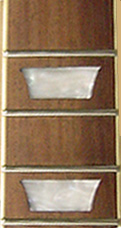
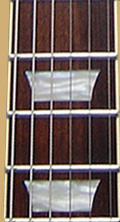
Photo:
Ludvig Nylund - http://www.multi.fi/~nproject/thursday_burst/
Here's another, after one treatment!

Results
may vary for many reasons. Even with a brand new guitar, one often has no idea
of how the surface was finished by its maker. The same applies with a used instrument.
If it had been treated with any of the countless substances that I hear about:
waxes, silicones, furniture polishes, mineral oil, "Lemon" oil, or ordinary
skin oil and dirt, it may be necessary to remove this gunk prior to treatment
with Fret Doctor![]() .
I am told by many guitarists that Formby's
Deep Cleansing Buildup Remover does a excellent job. There may be others.
You can then allow Fret Doctor
.
I am told by many guitarists that Formby's
Deep Cleansing Buildup Remover does a excellent job. There may be others.
You can then allow Fret Doctor![]() to do its stuff. Formby's won't remove varnishs like Linseed or Tung oil. The
Fret Doctor
to do its stuff. Formby's won't remove varnishs like Linseed or Tung oil. The
Fret Doctor![]() will
merely pool on the surface but will not penetrate at all. You will observe little
or no difference. In this case, you need either sanding or a paint stripper. I
don't want to go there. Don't ask.
will
merely pool on the surface but will not penetrate at all. You will observe little
or no difference. In this case, you need either sanding or a paint stripper. I
don't want to go there. Don't ask.
For
those who wish to truly blacken a board, Fret Doctor![]() will not do what you want. You can make a board black with leather dye, wood stains
or other means. It will "darken" both the board and maybe your fingers
but will do nothing to protect it. It might be still a good idea to preserve the
wood with Fret Doctor
will not do what you want. You can make a board black with leather dye, wood stains
or other means. It will "darken" both the board and maybe your fingers
but will do nothing to protect it. It might be still a good idea to preserve the
wood with Fret Doctor![]() first. Be sure that you are "blackening" your board for the right reasons.
Many old guitars came with Rosewood boards, in natural Rosewood color. They were
treated at one time or the other with Linseed oil, which oxidizes over time, and
turns black. The originals, in many cases, were not black at all! Only the Ebony.
first. Be sure that you are "blackening" your board for the right reasons.
Many old guitars came with Rosewood boards, in natural Rosewood color. They were
treated at one time or the other with Linseed oil, which oxidizes over time, and
turns black. The originals, in many cases, were not black at all! Only the Ebony.
Think of it as insurance!
Don't
concern yourself with "oversaturating" the wood. There isn't
that much air space in it. This isn't Balsa wood we are using here. If
it won't take any more, it is full, like a beer mug. Any additional oil will simply
wipe off. I am also told that Fret Doctor![]() also works well on acoustic bridges and bridge pins. I suggest that you apply
it a few times per year, or at string changes.
also works well on acoustic bridges and bridge pins. I suggest that you apply
it a few times per year, or at string changes.
Please
remember that Fret Doctor![]() is not "just another bore oil." A bottle of most bore oils and fretboard
treatments contains about a dime's worth of mineral oil. Fret Doctor
is not "just another bore oil." A bottle of most bore oils and fretboard
treatments contains about a dime's worth of mineral oil. Fret Doctor![]() is composed of a complex mixture of rare and expensive vegetable-based oils imported
from all over the world. That's why it works so well. If money is an issue, go
to the drugstore and buy a pint of mineral oil. It will make the board look nice,
but will do nothing to preserve it.
is composed of a complex mixture of rare and expensive vegetable-based oils imported
from all over the world. That's why it works so well. If money is an issue, go
to the drugstore and buy a pint of mineral oil. It will make the board look nice,
but will do nothing to preserve it.
A
fretboard has a much larger surface area than a woodwind bore, so an amazing number
of orders had been steadily coming in for many multiples of the normal 15 ml size
of Bore Doctor![]() .
To accommodate these users, I made the oil available in more economical 30ml and
60ml sizes. It was renamed Fret Doctor
.
To accommodate these users, I made the oil available in more economical 30ml and
60ml sizes. It was renamed Fret Doctor![]() in order to more accurately address its application, but it is identical to Bore
Doctor
in order to more accurately address its application, but it is identical to Bore
Doctor![]() in every
way.
in every
way.
Famed luthier, Bob Willcutt, has taken over production, sales, and marketing of FretDoctor, worldwide. Consquently, Fret Doctor may be ordered from Doctor's Products now and in the future. For your information, Bore Doctor and Fret Doctor are identical except for the size of the container.
Orders can be placed in 15 ml, 30 ml
and 60 ml sizes at Doctor's Products: https://www.doctorsprod.com/product-page/fret-doctor#:~:text=Fret%20Doctor%E2%84%A2%20preserves%20and,and%20will%20not%20turn%20rancid.&text=New%20glass%20bottles%20and%20labels,bottle%20with%20previous%20style%20label.
Click "select" for the size that you want.
______________________________________________________________________________________________________________________________________
Still not convinced?
What's
about the most beat up piece of hardwood that one ever could find? I own a maple
cutting board that I bought at a garage sale some 30 years ago. It had to have
had another 20 years on it when I got it. Since then, it has been abused by my
favorite high-carbon steel carving knife and a meat cleaver countless times. Below
are a photo taken before I did anything and another one taken after light sanding
and little bit of Fret Doctor![]() .
What more can I say? The oil is food-safe...I could use it on
a salad!
.
What more can I say? The oil is food-safe...I could use it on
a salad!

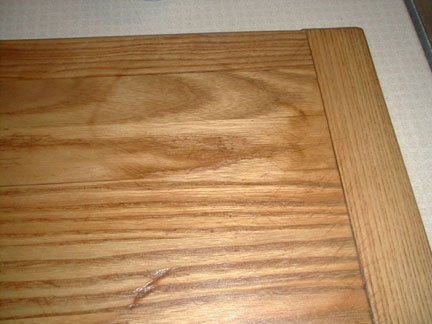
After 8 uses with a butcher knife & cleaver and 8 washings in a dishwasher:
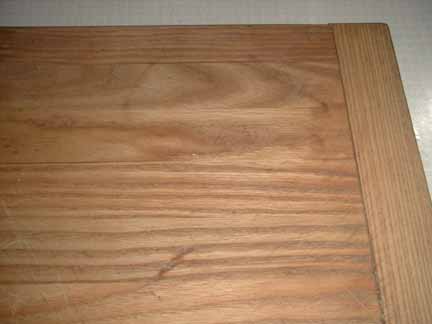
After
one more treatment with Fret Doctor![]() ,
with no sanding:
,
with no sanding:
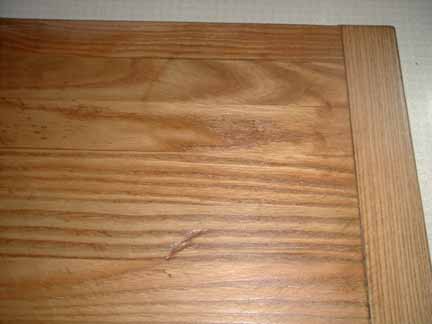
Other uses:
I have had
a beautiful cherry wood buffet for years. A while back, while nobody was home,
a storm blew up and a lot of rain blew in through an open window. The surface
got very badly messed up. From time to time, I worked on it with this and that,
but it still looked pretty bad. I rubbed it down with Fret Doctor![]() daily for about a week. It looks great now. It doesn't do a bad job with alcohol
stains, either. My wife is running around the house putting it on all of
our furniture. The little vials of Bore Doctor
daily for about a week. It looks great now. It doesn't do a bad job with alcohol
stains, either. My wife is running around the house putting it on all of
our furniture. The little vials of Bore Doctor![]() don't last too long. Fret Doctor
don't last too long. Fret Doctor![]() is less expensive.
is less expensive.
I
bought an authentic Civil War Firth & Pond fife, engraved with the name of
its owner, "Jos. Ahern." It was badly warped and had some cracks in
it. It did not play at all. I put a second cork in the long end, and filled it
with Fret Doctor![]() ,
leaving it in a horizontal position for about a month. The warp disappeared
and the cracks closed. It plays now, not well, but no Civil War fife ever did
by today's standards. It looks great!.
,
leaving it in a horizontal position for about a month. The warp disappeared
and the cracks closed. It plays now, not well, but no Civil War fife ever did
by today's standards. It looks great!.
